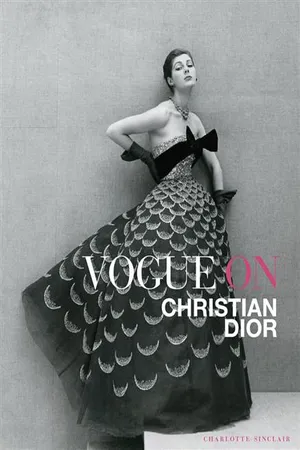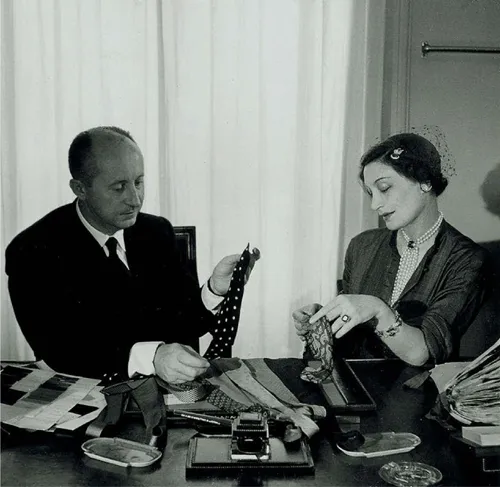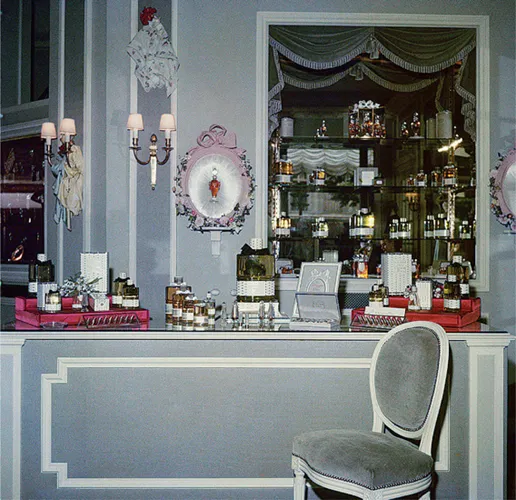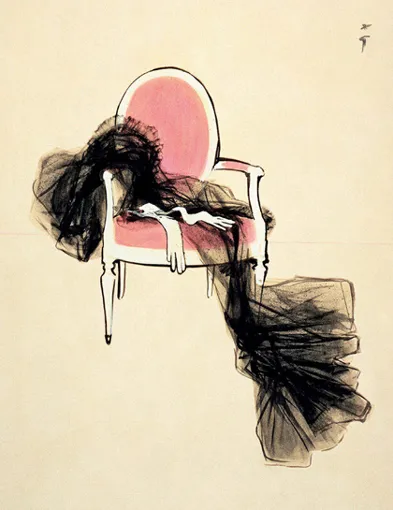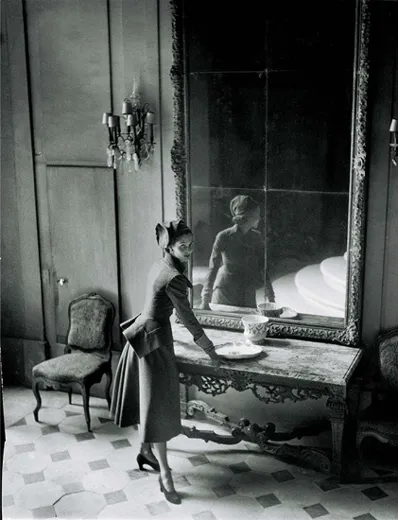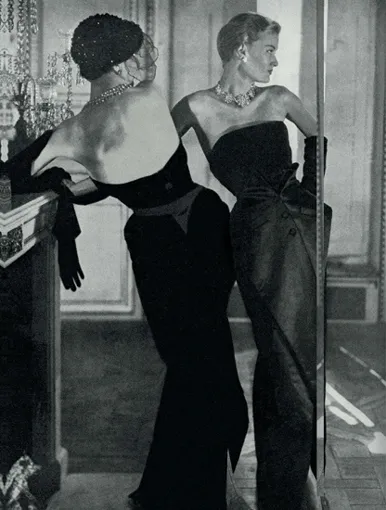![]()
A
THE VERY NOTION OF HAUTE COUTURE is founded on elitism, its elevated status evident even in its name—haute couture. In an industry which produces bespoke clothing in the service of a privileged few, it is all the more remarkable that a couturier ended up dressing the world. Captured and disseminated by a powerful media, Dior’s full-skirt-nipped-waist silhouette was the pervasive postwar look, worn by everyone from aristocratic grandes dames to American teenagers (that newly discovered species who teamed their swinging skirts with bobby socks and pony tails). But Dior’s intention had never been to design for everyone. Quite the opposite. He had declared to Marcel Boussac in 1946 that the house of Dior should cater only to “a clientele of really elegant women.” That he was able to create ball gowns for the Duchess of Windsor, while contemporaneously signing his name to stockings, men’s ties, perfume, gloves, jewelry, handbags, and furs is a mark of how successfully Dior fused the distinct worlds of commerce and couture.
Dior’s business nous developed at breakneck speed. On the advice of his financial director Jacques Rouet, the couturier signed a deal to create Parfums Christian Dior a mere eight months after his debut. Understanding the need for haute couture to adapt to the American market, in October 1948 he founded Christian Dior New York, a Fifth Avenue store which sold ready-to-wear lines designed specifically for the American woman. Time magazine wrote, “The dresses will be a ‘conservative evolution’ of his Paris models, designed with one eye on the US tastes and the other on the limitations of machine production.” In that same month he opened Christian Dior Furs and a millinery department in Paris. By 1949 he had signed his first license contract—the first couturier ever to have done so—for a range of stockings.
Corset-makers, jewelers, and furriers beat a path to Avenue Montaigne. Guided by Rouet, Dior exchanged one-off fees for a cut of the royalties, ensuring a constant revenue stream for the house. Such was the pace and volume of these new export, wholesale, and licensing agreements, that in 1950 Dior set up a specific department to marshal his business ventures. In the same year, the output from Maison Christian Dior equaled more than half the total export profits for the entire Paris couture industry. Dior was awarded the Legion d’Honneur by the Ministry of Trade and Commerce in recognition of his contribution. By 1957, Maison Dior had established licenses in 87 countries—from Canada to Cuba, America to Australia.
Hat, gloves, cigarette, and champagne: modeling Dior’s accessories and lifestyle for Vogue, December 1957. Photograph by Henry Clarke.
Christian Dior and Mitzah Bricard selecting ties to be sold as Dior accessories.
Parfums Christian Dior at the Dior boutique.
Behind “their facades of perfumes, of organdie and mannequins”—as Dior stressed to Cecil Beaton—couture houses “were commercial enterprises where the least yard of mousseline [muslin] becomes a figure on a page, where the collections of each season become the francs and the sous of hundreds of employees who cater to that amorphous monster, the general public of women.”
The world of couture might, in the public eye, appear frivolous, but its foundations were built on rigorous financial calculation. “I risk the salary of nine hundred persons in making a collection,” Dior told Beaton.
Unsurprisingly, then, Dior approached the building of his empire with the same strict framework that he brought to his clothes, a carefully stratified architecture that included couture at its apex, and a pair of Dior-label stockings at its base. In such process he created the model for the modern fashion house, where the majority of a designer’s profits are rendered by ancillary products: handbags, sunglasses, makeup, and perfume. Dior was selling a romantic concept of Paris couture with its attendant murmur of wealth and privilege, a dream which now everyone could buy into.
“A woman’s perfume tells more about her than her handwriting.”
CHRISTIAN DIOR
An example of René Gruau’s characteristically glamorous drawings for Dior’s advertisement campaigns; here Gruau appropriates couture’s patrician elegance to sell Diorama perfume.
A model rests in front of a mirror in a Dior gray flannel suit with full-back skirt, photographed by Clifford Coffin for Vogue, October 1948. Even as his line trickled down to stockings, ties, and fragrance, Dior’s appeal rested upon the kind of refined image encapsulated here.
And why shouldn’t haute couture and perfume be two sides of the same coin? Or, even, reflect two sides of the same man? “It was true that I was a French couturier, but I had to understand the needs of elegant women all over the world as well as my fellow countrywomen,” as Dior wrote in his memoirs. He considered it an extension of good manners, (and excellent business sense), that every woman should be able to glean a little Dior magic. “Dior never forgot his customers,” wrote Bettina Ballard, “the commercial ones, the private ones, and even the out-and-out copyists.”
Papered with toile de Jouy, perfumed with Miss Dior, the Paris boutique was a scale model of this vast enterprise. Vogue described a July 1955 visit in whimsical terms: “The Dior boutique at 30 Avenue Montaigne is crammed with a lot of lovely small items – scarves, stockings, handkerchiefs, tiny pieces of jewellery, which make delightful presents at a reasonably modest cost, as well as the heavenly semi-couture clothes (one fitting, or alterations if necessary).” There were shoes too, by Dior’s in-house shoemaker, Roger Vivier, available both ready-made and bespoke. “I wanted a woman to be able to leave the boutique dressed by it from head to foot, even carrying a present for her husband in her hand,” Dior wrote. “All the activities which were now associated with my name, were to be found within these walls of the boutique: the stockings, gloves, and perfumes, whose rise to fame has been parallel to that of my house itself.”
In the postwar world of conspicuous consumption, of advertising and Cadillacs, washing machines and jet planes, Dior’s timing was perfect. Women rushed to his Paris boutique, the pleasure of a visit derived in browsing its wares as much as in the thrill of bearing home a small gray Dior box, tied with white ribbon. The soothing, scented atmosphere of the boutique stood in contrast to the frenzy of professional buying after each season’s show. Twice a year, Paris was flooded with Americans, as Time magazine’s Stanley Karnow recalled. “In the district around the Champs-Elysées, the George V, Prince de Galles and Plaza Athénée lounges were shrill with the shouts of Chicago and Dallas department-store buyers as they cruised from divan to divan, hailing California and Florida dress-chair representatives. At plush restaurants like Lasserre, Ledoyen and Maxim’s, stocky, cigar-chomping Seventh Avenue manufacturers in silver ties and white-on-white shirts shared tables with New York designers in jangly bracelets and rhinestone-rimmed glasses.”
A
“IN FRONT OF THE MIRROR, SURVEYING THE FINAL RESULT, THERE YOU WERE, COMPLETE: COMPLETELY DIOR TOO!”
OLIVIA DE HAVILLAND
A lean-cut dress from Dior’s “Long” line is completed with a fur muff and matching fur-lined coat and hat, each element of the outfit conceived by Dior. Photograph Henry Clarke.
Elegant fashions in opulent Paris salons, the domain of Dior’s haute-couture clientele. Two bejeweled women in Dior ball gowns photographed by Horst in 1949.
Dior pink from top to toe: a swing coat from 1955’s “A” Line photographed by Karen Radkai.
This was the moment that Dior’s clothes ceased to be his “children” and became “objects of commercial value,” the couturier wrote. Representatives of department stores around the world paid large deposits for their seats in Dior’s salon, (a safeguard against plagiarism and time-wasters), which were arranged by strict protocol. (An obscured view was a vendeuse’s revenge for a low order on a past collection.) The couturier’s new line was viewed by this poker-faced pack, then “probed minutely for hours,” recalled Dior. The clothes were “measured, turned inside out, unstitched, sometimes literally pulled to pieces, in order that they may yield up their secrets. We are lucky if buttons and embroideries are not torn off as samples or souvenirs.”
Some modeles were ordered in large quantities to sell, some were bought individu...
